
I would like to say that it is impossible to create historically correct clothes to reenact nordic viking age, simply because we have so small textile finds and very few pictures. There is always more to learn and I am not an expert in any way. So please dont take my interpretations for facts, they are just guesses based on the knowledge I have at this moment. (januari 2018)
I have been inspired and made my interpretations based on burial findings from Björkö / Birka.
I try to reenact the clothes of a relatively wealthy woman around thirty years old, living on a smaller farm near Birka in the early 900’s. She is responsible for the farm when her husband and some of the children are away on trading around the Baltic Sea. I have tried to use materials that are “common” in the burial findings from this area / time. But as usual in viking age reenactment we have very few and hard-to-understand sources so my costumes are based mostly on guesses and assumptions. But it was fun to look in the archives and make an effort!

Petticoat
Handsewn petticoat in undyed linen. Kneelong because I think it was the most practical length in clay, snow and with monthly bleeding.
Kneehose
Undyed kneelength woolhose. I guess that you did not struggle to dye everyday clothes that was mostly unseen. Also, I think hoses became worn quiet fast and you had to sew new ones often when they fell apart. These are hand-sewn with waxed linen thread.
Shoes
Thin leather shoes. (From Ola and Beatrice at Craft Hive) Model is from archaeological finds in Holland 900-th, but I have seen several similar models among finds here in the north to.
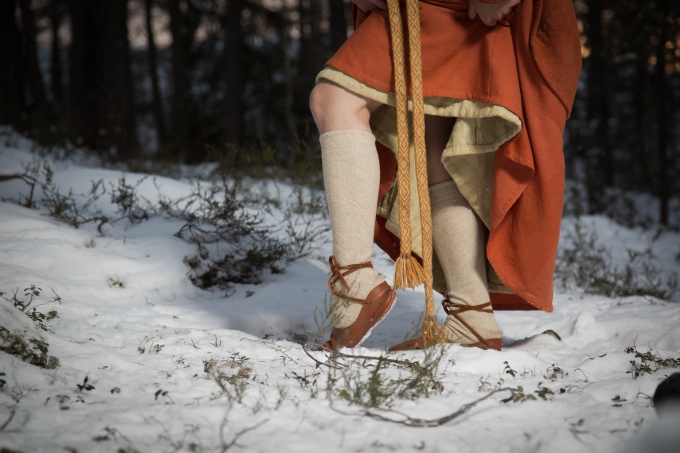
Working dress or between dress
Handsewn in natural white organic twillwool. In women’s grave Bj 838 there is a find of tvillwool so I have chosen it for the everyday-dress and for the coat as well.
I have plant dyed the fabric with Vau. It produces a permanent yellow color and was growing wild in this area in vendel/viking age and still today. Both Hägg and Geijer mention in their texts colorresidues on textiles from Björkö in red from madder root, blue from vejde, yellow from vau, brown and uncoloured. The dress is with hand-sewn in straight panels with wedges in front, back and sides. Has no source of finds that backs up so many wedges but I wanted to use the whole fabric without any leftover pieces and get a width that is practical when working, riding etc.( All the leftover fabrics could fit in my closed hand. ) The neckline is held together by a small round brooch in bronze from Burr at historiska fynd.se. This brooch is based on Bj 1095, but there are many women graves around Birka with a similar brooch at the throat so they appear to be common. It has also been found in my inspirational grave bj 838.

Headscarf
I think that a simple scarf in thin woven linen would be the most practical to have to protect your head from cold and sun during normal working days. It is also likely that such an unglamorous pice of clothes was not something you were buried with. So, I don’t have any finds to back up this assumption but I still choose a thin woven scarf in linen to keep the hair in place and warm my ears when doing daily life.
Apron
Has no source material or findings here either but I thinks it would be likely to have a easy-to-wear protective-apron when working, cooking food, etc. My idea here is that you do not sew more than you need on a workwear like this so my apron is a rectangular piece of undyed linen that I simply attach around the waist with a tablet woven band in wool.
Women coat
Short women coat in organic wool that I dyed with walnut bark in a thin color bath and then dyed over with madder. The coat is held together with a equal-armed-Brooche from historiskafynd.se and it is based on a find from the Black Earth, bj 902 and 969. As I understand it, a common Brooche in women’s graves from the area around the 800-th and 900-th.
Shawl
A shawl I dyed with walnut bark. The fabric is hand-woven, thick diamond twill wool made by Raminta Berzanskyte. The ring buckle is based on a find from Hablingebo in Gotland, so not a find from the Birka, but I am very fond of it and think it could have been a gift from someone close to the women I reenact.

Apron dress
Very thin diamond twill which, according to the supplier “Handelsgillet”, should be a reproduction on the fabric fragments found at Birka 800-1000. I have dyed the fabric with madder. Sewed narrow straps in undyed linen. In women’s grave, Bj 838 writhes Hägg that the fabric in diamond twill is a apron dress with some kind of woolbraid along the edge so I chose to decorate the edge with a braid of wool yarn dyed with vejde. Also sew on a narrow strip of gold-yellow patterned silk from Max at “Kvalitativt krigsbyte” . The patterned silk are loosely based on a silk fragment from bj 944.
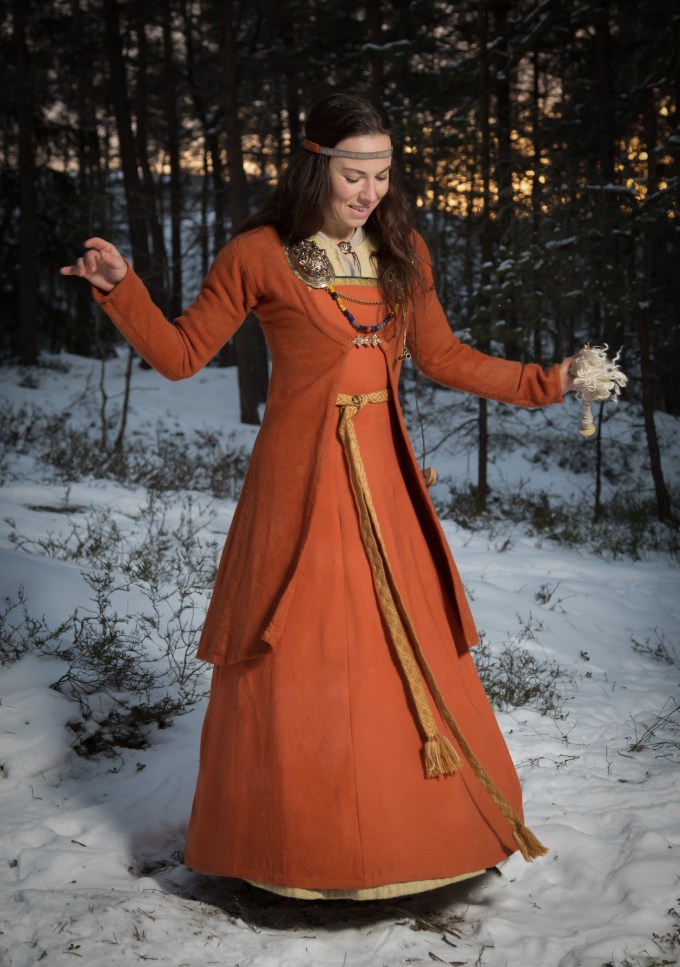
Brooches, Beads and other Bling
The apron dress is held together with large double-skinned brooches in bronze of the variant p51 mede by Kram Szepczace Kruki in Poland. I’m not an expert on this and may be wrong but the perception that I got from searching around in the Historical Museum collections is that p51 was the most common dubble brooches in Birka. In addition, there is also many finds of molds for this type of oval brooches. This ones are perhaps unusually large but there are finds of p51 which is 12*6 cm, same size as this ones I have. And in women’s grave bj 965 at Björkö, the variant p52 are really big, about 13*7 cm. In grave bj 838, buckets of variant p51 were also found.
I have read on the history museum’s website that over 6000 glass beads have been found in the black soil, the most common is single-colored glass beads in blue and yellow, although a multitude of colors and patterns has been found. Then there are finds of 350 pearls in other materials, for example, crystal, carneol, amber and clay. Since glass beads, like many other things, probably were a valuable import product in Birka, I have chosen to decorate my apron dress with only one row of beads in yellow and blue glass and red rock crystal.
From the brooches, I hung a bronze chane and needlehouse with bronze needles in it, similar needlehouses have been found in several graves around Birka, including in bj 935.
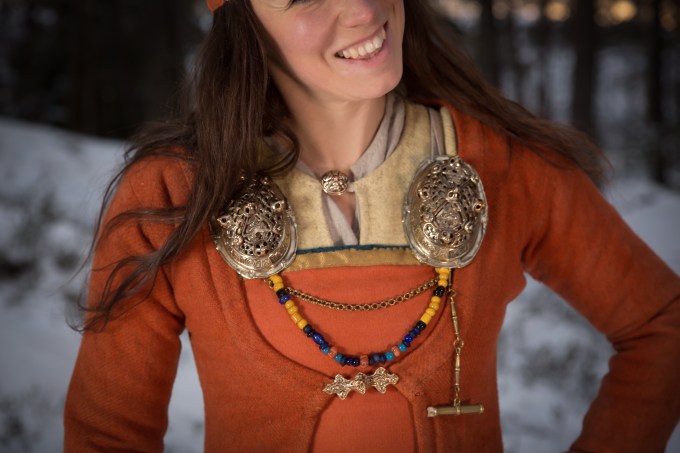
Silverwoven headband
I wanted to sew something to wear on my head and hair on festive occasions based on findings made around Birka in a women’s grave. There is very little source material to go on and I just have to guess and make big assumptions here. But Geijer writes about a women’s grave with a silver-woven silktablet over the forehead of the skull. (bj 571) Geijer writes that the band is in pattern B24 but there is no pattern image on B24 so I have bought a silver-woven silktablet in the pattern B17 instead. That patterns was found in bj 735. I chose that pattern because it was the same dimensions as in the bj 571 and I simply like it. I sew the band together with a piece of my madderdyed diamondtwill and wear it like a hairband over the forehead. This is just my own interpretation, but I do not see it as unreasonable if you look at historical costumes from around the Baltic Sea, where women often wear different metal-wrapped tablets around the forehead.
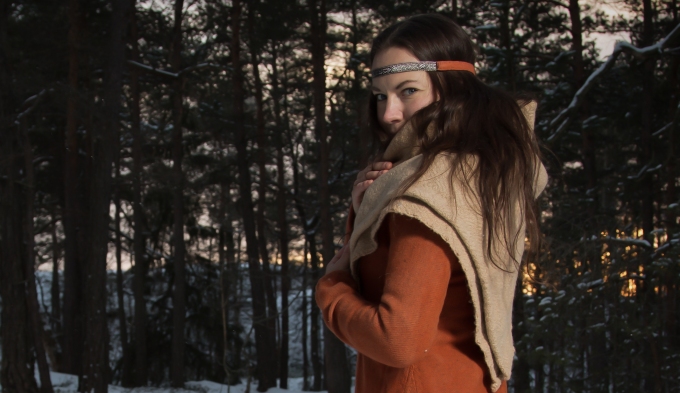
Belt
Woven tablet in plantdyed wool with a small iron ring to hold it in place.
Bag
Shoulder bag in brown wool. The wooden shackles are based on a marine finding from the coast of Birka and I have received them from my good friend Kalle.
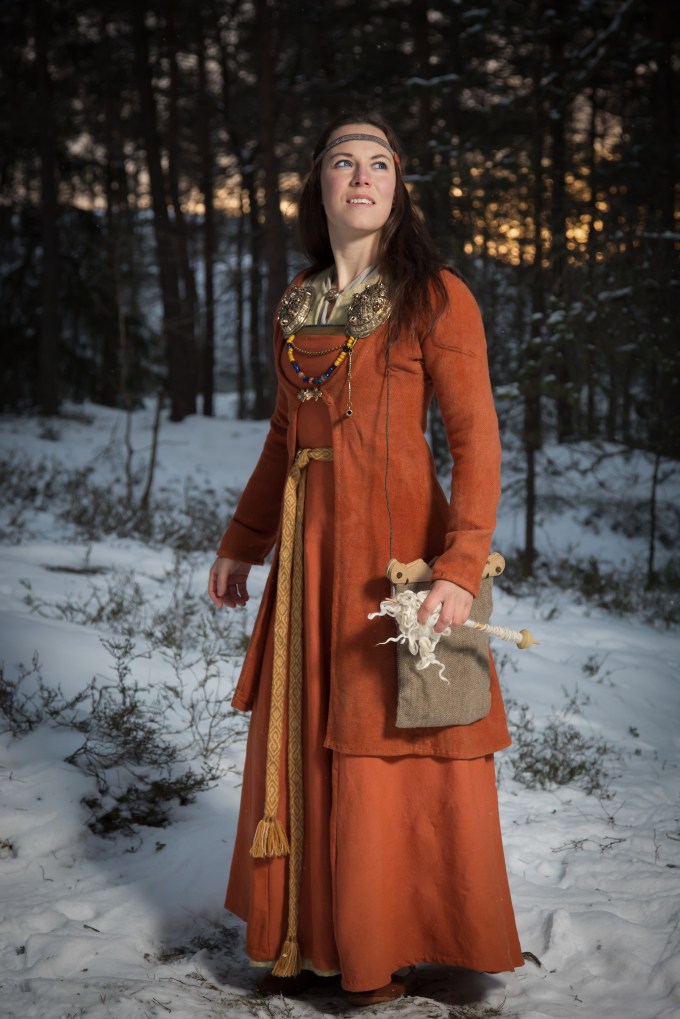
In addition to searching around a lot in the Historical Museum Collections from Björkö (http://mis.historiska.se/mis/sok/birka.asp?sm=10_7) I have also read some parts of: Hägg, I., 1974 The women’s apparel in Birka, Geijer, A., 1983. The textile finds from Birka. I: Cloth and clothing in medieval Europe, 80-99 and Geijer, A., 1938. BIRKA III.
Hello,
Your enthusiasm is wonderful.
When dealing with historical garments there is usually a bit of guessing. Even with pictures of actual garments, people still have personal likes.
I am involved with Elizabethan period reenacting, there are definite styles and fabrics, but people chose special designs etc;
Keep searching and learning
You may know some people in Sweden that I know, Anders Gidenstam, his wife and brother Hans
My name is Michael
LikeLiked by 1 person
Thanks! I don’t know Anders and his family personally but I know about them. Would love to see some of your Elizabethan period reenacting. 🙂
LikeLike